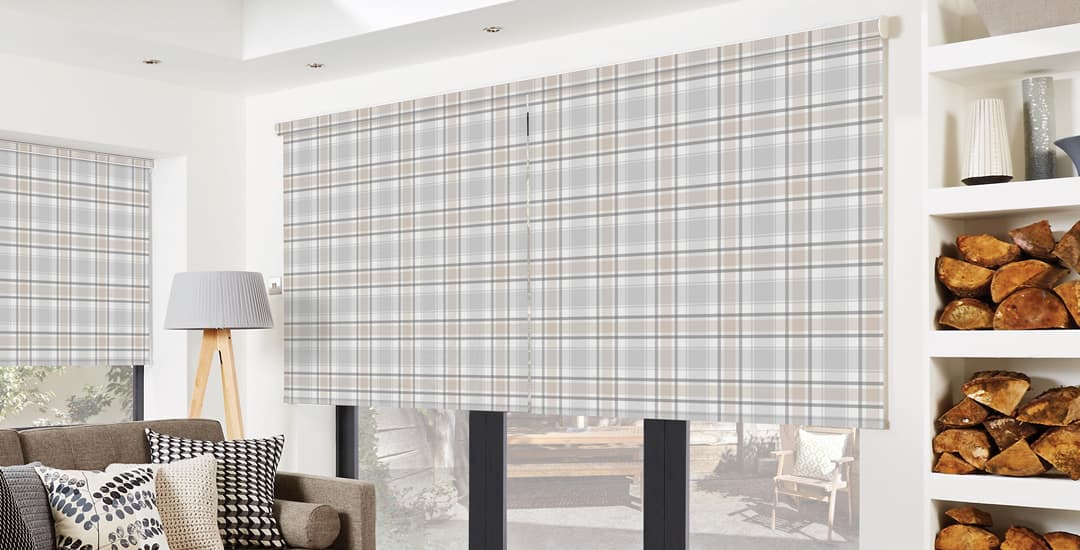
Does it matter if roller blinds are too long? No, because even if your blinds are far longer than the drop they’re intended to cover, you don’t need to roll them out to the full extent of their length, and can simply stop them before they start to form their own train!
Another question that often comes up regarding what length roller blinds should be and how far they should be extended, is should roller blinds touch the floor, or stop a little way above it? We generally advise not allowing your roller blinds to roll down to the point that they come into contact with the ground, for reasons that I’ll get into in more detail later on.
Why might roller blinds be too long?
Starting with the basics, let me just clarify what I mean here when I talk about roller blinds being too long, and cover why they might be longer than needed in the first place. If what you were thinking of when you Googled “does it matter if roller blinds are too long” actually relates to the width of the fabric and the roller blind being too wide for the window it’s on, I’ll cover that alternative scenario at the end of this post.
For the purposes of this initial explanation though, saying that a roller blind is “too long” means that the fabric part of the roller blind has a longer drop than is needed, so that it could theoretically come down below the bottom of the window by quite a ways, potentially to the point that it pools on the floor if fully extended.
Why might this happen anyway though? Roller blind fabrics being longer than the window is actually more common than not, and it’s perfectly normal and acceptable, and isn’t due to mistakes when you measure up, nor manufacturing malfunctions due to us here on the production side of things being unable to maths…
To demonstrate, if we’re using a roller blind fabric that comes in 200cm lengths and you need a roller blind to cover a 160cm drop, you’re probably going to end up with the full 200cm length being use for your roll, because there’s no functional or cosmetic reason to cut the fabric shorter and we can’t do a lot with tonnes of individual 40cm strips of fabric!
Leaving these small amounts of excess fabric length intact simplifies production by requiring us to make just one cut to the fabric to create the appropriate width, enabling us to streamline production and keep costs down.
Having a blind that’s longer than it actually needs to be doesn’t cause any issues nor reveal itself visually when the blind is in use, but it does come with one potential advantage.
If the bottom of the blind gets damaged, scuffed, or grimy over time by contact with the windowsill, floor, or simply from everyday handling, you may have the option of cutting off the very bottom part of the fabric and having the remaining edge re-stitched into a new pocket to restore the blind’s appearance.
Does it matter if roller blinds are too long?

No, it doesn’t matter if the fabric of a roller blind is too long, or more to the point, longer than the minimum length it needs to be. This causes no functional issues and isn’t visible, as the additional length remains rolled up around the tube at the top.
This is certainly the case with modern roller blinds – by which I mean post-millennial ones, which must surely be well over 99% of all roller blinds in use today – because they’re raised and lowered using a chain and a precision sidewinder control. This enables you to position the blind’s fabric and drop exactly where you want it to be, however OCD your tendencies might be in this respect.
I am advised by some of the workshop pros downstairs who were cutting and crafting roller blinds since before I was of legal drinking age that the “does it matter if roller blinds are too long” thing became a question in the first place due to the older-style roller blind controls that used to be the norm back when The Spice Girls were just starting to tell us what they really, really wanted and before.
Older-style roller blinds were generally made with spring-loaded controls, which offered less precision in terms of allowing you to dictate where the bottom of the blind lay when you extended it. That being the case, creating roller blinds to the exact drop required was a rather more highly-loaded and pertinent endeavour.
With that said, even spring-loaded rollers were generally made with a small additional fabric buffer to ensure that the top tube of the roller wasn’t exposed when the blind was extended, and to allow for the need to pull the bottom of the blind down a couple of notches in order to release the tension in the spring to enable it to rise again.
This latter being the case, you wouldn’t have the necessary level of give in the fabric to be able to do this if the blind had already reached the full extent of its length when it was lowered to the desired level.
Should roller blinds touch the floor or alternatively, windowsill?

We’ve looked in quite some detail at whether or not it’s a problem if a blind is too long or has more fabric along the vertical than is strictly needed; but how long should a roller blind extend to anyway, and should roller blinds touch the floor?
Ideally no, we advise you not to extend your roller blind down to the point that it’s grazing or pooling on the floor when open, and to stop just before it skims the floor at a few mm above it. This is simply to stop the bottom of the blind picking up the inevitable floor dust and grime that collects there over time, so that the blind remains in good condition for longer.
If you’re talking about a roller blind covering a window that’s not floor level and are wondering where to stop with the rolling, again, a few mm above the windowsill is advised for blinds hung inside of the window recess, and a few cm below the level of the sill for blinds hung outside of or over the recess.
Does it matter if roller blinds are too long for the window horizontally?

This is more a question of “does it matter if roller blinds are too wide for the window” (in terms of the width of the roll/fabric around it), but people do commonly phrase this as “does it matter if roller blinds are too long for the window” instead.
This has caused a lot of confusion on both sides when I get emails along these lines and then start banging on about vertical length and how close your blinds should come to the floor!
So in closing then, does it matter if roller blinds are too long for the window horizontally or widthways? Yes, in this situation you’re possibly going to have a problem.
A roller blind that is too long widthways won’t be the end of the world if your blind is intended to be hung outside of or over the window recess – and in fact, we do advise ordering your blinds with a buffer of at least 10cm over all four sides to minimise light leakage around the sides of the blind.
However, if you’re planning to hang your blind inside of the window recess and the blind is too long widthways, well, I draw your attention to those photos/videos online of dogs trying to carry an overly wide stick through a gateway or gap, and ask you to use your imagination, as this is the perfect allegory for what’s going to happen with your blind when you try to fit it.
Having a blind that’s too long widthways isn’t a situation that will ever crop up unless you’ve measured up incorrectly or perhaps changed your mind about wanting to hang the blind outside of the recess; or maybe if you’ve bought a readymade roller blind that came with bold claims of “easy to cut to size” but that in fact, proved to be anything but.
Does it matter if roller blinds are too long/touch the floor/are too wide: The CliffsNotes
- Does it matter if roller blinds are too long in terms of the length of their fabric? No.
- Should roller blinds touch the floor or windowsill? No, they should stop a few mm above it.
- Does it matter if roller blinds are too long for the window horizontally? Yes, and should you find yourself in this position I’d be quite interested to hear how it happened, so drop me a line.




